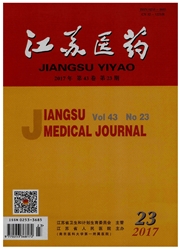

 中文摘要:
中文摘要:
目的:探讨氯吡格雷低反应性与冠状动脉支架内血栓的关系,评估氯吡格雷剂量加倍后的疗效。方法连续人选9例经冠状动脉造影确诊的支架内血栓患者为观察组,连续人选100例接受支架植入治疗的冠心病患者为对照组。用光学血小板聚集仪检测花生四烯酸(AA)和二磷酸腺苷(ADP)诱导的血小板聚集率(PL从和PLAm)。将PLAA〉20%、PLADP〉40%分别定义为阿司匹林和氯吡格雷低反应性,对观察组氯吡格雷低反应者加倍剂量至150mg/d,随访PLADp及临床事件。结果观察组氯吡格雷低反应的发生率高于对照组(100%VS.27%)(P〈0.01);观察组PLADp水平显著高于对照组[(53.6±6.3)%VS.(31.9±14.0)%](P〈0.01);观察组氯吡格雷剂量加倍后,血小板聚集率显著降低[(53.6±6.3)%VS.(37.o±10.9)%](P〈0.01)。观察组与对照组均未检出阿司匹林低反应患者。结论氯吡格雷低反应性是冠状动脉支架内血栓形成的危险因素。氯吡格雷剂量加倍可显著降低残余血小板聚集率,可能减少支架内血栓形成事件的发生。
 英文摘要:
英文摘要:
Objective To investigate the association between clopidogrel low response(CLR) and stent thrombosis (ST)and evaluate the efficacy if dose of clopidogrel doubled. Methods Arachidonic acid (AA) and adenosine diphosphate (ADP)-induced platelet aggregations (PLAA and PLAoP) were tested using the light transmission aggregometer (LTA) in 9 patients with stent thrombosis confermed by coronary angiography(group ST) and 100 hospitalized patients who received stent implantation(group C). Aspirin and clopidogrel low response were defined as LTA platelet aggregation in response to AA and ADP being greater than 20% and 40%, respectively. The dosage of clopidogrel was doubled with 150 mg daily for low responders in group ST. PLADp and the clinical events were followed up. Results The incidence of elopidogrel low response in group ST was significantly higher than that in group C(100% vs. 27%) (P〈0. 01). The average PLADp was significantly higher in group ST than that in group C [(53.6±6.3)% vs. (31.9±14.0)%] (P〈0. 01). After the dosage of clopidogrel was doubled in group ST, PLADP was significantly decreased [(53.6± 6.3)% vs. (37.0±10. 9)%] (P〈0. 01) . There were no aspirin low response patients in both groups. Conclusion Clopidogrel low response is a risk factor for ST. Double doses of clopidogrel can further inhibit the residual platelet activity, which may decrease the incidence of stent thrombosis.
 同期刊论文项目
同期刊论文项目
 同项目期刊论文
同项目期刊论文
 Efficacy and safety of cilostazol based triple antiplatelet treatment versus dual antiplatelet treat
Efficacy and safety of cilostazol based triple antiplatelet treatment versus dual antiplatelet treat Zinc supplementation results in improved therapeutic potential of bone marrow-derived mesenchymal st
Zinc supplementation results in improved therapeutic potential of bone marrow-derived mesenchymal st Simvastatin augments the efficacy of therapeutic angiogenesis induced by bone marrow-derived mesench
Simvastatin augments the efficacy of therapeutic angiogenesis induced by bone marrow-derived mesench Transplanted Human Amniotic Membrane-Derived Mesenchymal Stem Cells Ameliorate Carbon Tetrachloride-
Transplanted Human Amniotic Membrane-Derived Mesenchymal Stem Cells Ameliorate Carbon Tetrachloride- Plasma levels of lipometabolism-related miR-122 and miR-370 are increased in patients with hyperlipi
Plasma levels of lipometabolism-related miR-122 and miR-370 are increased in patients with hyperlipi Nine-year follow-up of local implantation of autologous skeletal myoblasts in a patient with coronar
Nine-year follow-up of local implantation of autologous skeletal myoblasts in a patient with coronar 期刊信息
期刊信息
